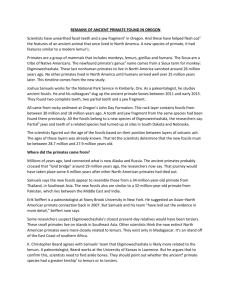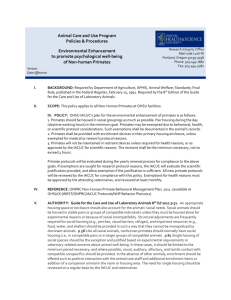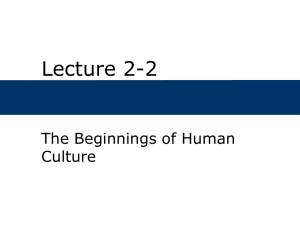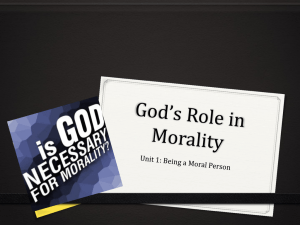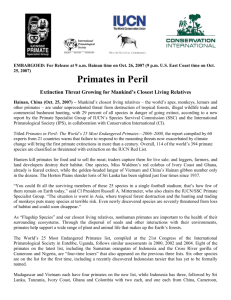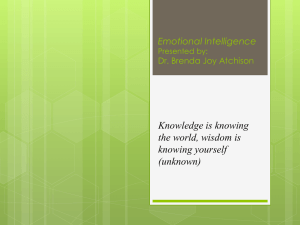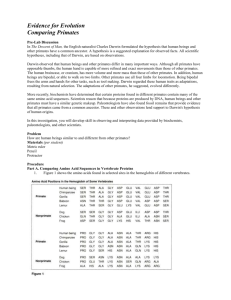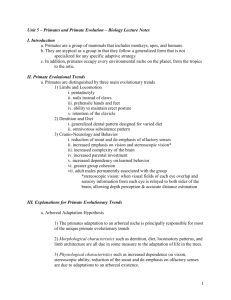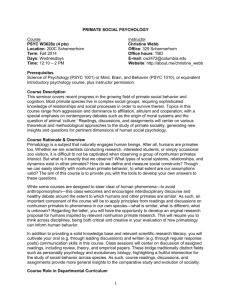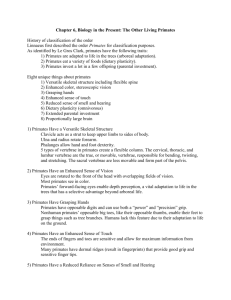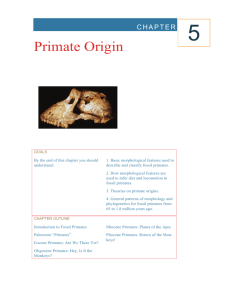Primate culture - Science and Business Management
advertisement
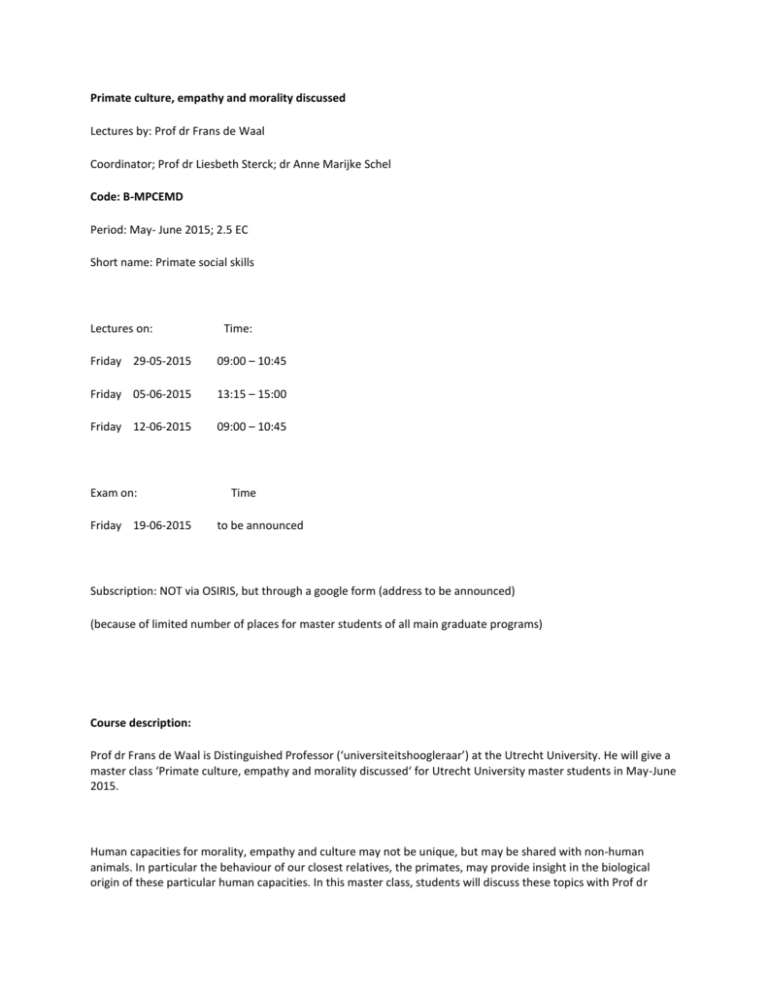
Primate culture, empathy and morality discussed Lectures by: Prof dr Frans de Waal Coordinator; Prof dr Liesbeth Sterck; dr Anne Marijke Schel Code: B-MPCEMD Period: May- June 2015; 2.5 EC Short name: Primate social skills Lectures on: Time: Friday 29-05-2015 09:00 – 10:45 Friday 05-06-2015 13:15 – 15:00 Friday 12-06-2015 09:00 – 10:45 Exam on: Friday 19-06-2015 Time to be announced Subscription: NOT via OSIRIS, but through a google form (address to be announced) (because of limited number of places for master students of all main graduate programs) Course description: Prof dr Frans de Waal is Distinguished Professor (‘universiteitshoogleraar’) at the Utrecht University. He will give a master class ‘Primate culture, empathy and morality discussed‘ for Utrecht University master students in May-June 2015. Human capacities for morality, empathy and culture may not be unique, but may be shared with non-human animals. In particular the behaviour of our closest relatives, the primates, may provide insight in the biological origin of these particular human capacities. In this master class, students will discuss these topics with Prof dr Frans de Waal, after reading the indicated literature and attending a lecture addressing the topic. The course involves three lectures with discussion. The topics are: Lecture 1: Morality; Lecture 2: Empathy; Lecture 3: Culture. The course will be examined with a multiple choice exam. See also below for more details. At the end of the course, students should have a profound understanding of: [if !supportLists]a. [endif]Current Insights in the topics concerning primate social behaviour and skills At the end of the course, students should be able to: a Compare and integrate primary literature b Formulate questions and discuss the topics Subscription only via: google form (address to be announced) Detailed description of the lectures Lecture 1: Morality A Darwinian View of the Moral Emotions in Man and Animals Homo homini lupus – “man is wolf to man” - is an old Roman proverb popularized by Thomas Hobbes. Even though it permeates large parts of law, economics, and political science, the proverb fails to do justice to the thoroughly social nature of our species as well as to that of canids, which are among the most gregarious and cooperative animals. For the past quarter century, this cynical view has also been promoted by an influential school of biology, followers of Thomas Henry Huxley, which holds that we are born nasty and selfish. Accordingly, it is only with the greatest possible effort that we can hope to become moral beings. Charles Darwin, however, saw things differently: he believed in continuity between animals’ social instincts and human morality. He wrote an entire book about The Expression of the Emotions in Man and Animals. Modern psychology and neuroscience support Darwin’s view about the moral emotions. Human moral decisions often stem from “gut” reactions, some of which we share with other animals. I will elaborate on the connection between morality and primate behavior. Other primates show signs of empathy (see Lecture 2), reciprocity, and a sense of fairness that promote a mutually satisfactory modus vivendi. I will review evidence for continuity to support the view that the building blocks of morality are older than humanity. Lecture 2: Empathy On the Possibility of Animal Empathy The possibility that animals have empathy and sympathy has received little systematic attention due to an excessive fear of anthropomorphism and the behaviorist taboo on animal emotions. Actual animal behavior, however, would lead one to agree with Charles Darwin that "Many animals certainly sympathize with each other's distress or danger." In my own work with monkeys and apes, I have found many cases of one individual coming to another's rescue in a fight, putting an arm around a previous victim of attack, or other emotional responses to the distress of others. In fact, the entire communication system of nonhuman primates seems emotionally mediated. In this presentation I will review expressions of empathy in animals, especially nonhuman primates, and present a "Russian doll" model of how animals perceive others. It ranges from a core mechanism of emotional linkage arising from a direct mapping of another's behavioral state onto the subject's representations. This Perception-Action Model provides the basis for higher levels in which there is an increasing distinction between self and other, so that the other is recognized as the source of felt emotions. This permits responses to be geared specifically to the other's situation, thus increasing the effectiveness of sympathetic support, care, and reassurance, as observed in dolphins, apes, and elephants. The connection between perspective-taking and mirror self-recognition (MSR) will be elaborated upon, including our recent demonstration that Asian elephants recognize themselves in a mirror. Lecture 3: Culture A Social, Political & Cultural Brain: What Primates Know About and Learn From Each Other Primates live in complex societies in which they compete, try to become dominant, but also help friends and kin. At Living Links we test the knowledge of monkeys and apes about each other, including the power relations among primates, described first in my book Chimpanzee Politics (1982). Several recent experiments will be discussed, such as a) the role of policing by high-ranking “peacekeepers” and how their behavior stabilizes society, b) how primates distinguish gender - do they have a gender "construct" in that they find it easier to determine the gender of familiar individuals, c) how do chimpanzees and bonobos complement "regular" primate communication (facial expressions and vocalizations) with hand gestures and does this bear on language evolution, d) what do primates learn from each other - do they have cultural capacities in that they adopt behavior shown by others in their group? It is known from the wild that many animals, especially our closest relatives, show cultural variation. That is, their behavior differs from group to group based on the transmission of knowledge, skills, or habits. We now speak of the up and coming field of "cultural primatology."
